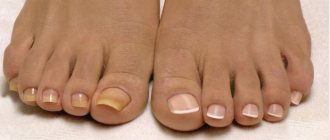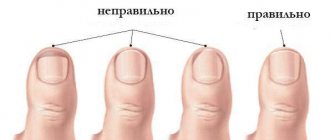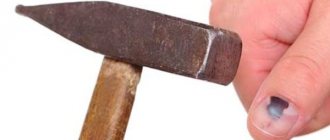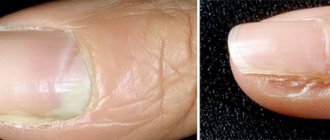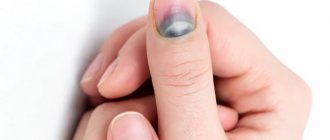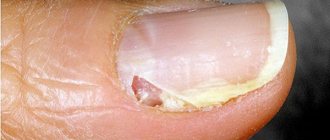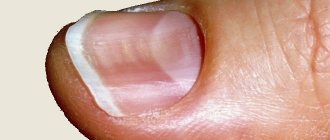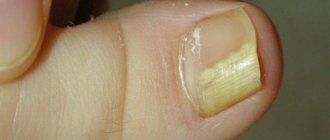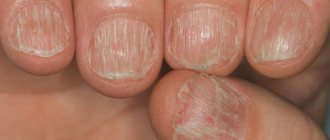Beautiful and well-groomed feet cannot be imagined without healthy nails. A change in the shape and color of this horny plate is not only a cosmetic defect. Deformation of toenails can be a symptom of a dangerous pathology that requires serious treatment. You should carefully monitor your pedicure not only in the summer, when you can show it off to others. In order for the body to remain healthy and beautiful, it must be constantly looked after.
Deformation of the nail plate
The main function of nails is to protect the fingertips and their nerve endings from mechanical damage. The plates consist of layers of keratin, between which there is fat and water. Their hardness depends on the sulfur content in the body. Therefore, the density of nails is different for all people.
Each plate consists of the following parts:
- Root. It is not visible because it is under the skin.
- Body. The main part of the record.
- Edge. The regrown part that comes away from the skin.
The rate of nail growth depends on the time of year, gender, heredity, physical activity, nutrition and age of the person. On average, records on hand are completely renewed within six months. Toenails grow more slowly. It may take a whole year for them to change.
Deformation of toenails and fingernails may indicate problems in the body. A healthy plate has a pink color, a uniform and smooth surface. Various compactions, changes in shade or the formation of spots may indicate problems with the kidneys, heart, or indicate endocrine disorders.
It is especially unpleasant when deformation of toenails occurs. Usually it is not noticed immediately. The nail manages to change shape to such an extent that it interferes with walking, causing severe pain. In advanced cases, complete or partial removal of the plate may be required. Nail prosthetics will help restore your feet to a beautiful and healthy appearance.
Non-fungal nail diseases and prevention
Mechanical damage to a finger can cause disease on the feet. An ordinary bruise causes white spots called wounds to appear on the plate. The formations indicate the development of dystrophy and calcium deficiency. The spots gradually disappear as the nail grows.
If the nail takes on a blue tint, a bruise forms; the pathology is hidden in the burst vessels that form the bruise. It will be necessary to reduce the pressure in the sore spot, preventing complete detachment. When the nails peel, it is necessary to remove the damaged areas. Dystrophy is expressed in excessive flexibility of the nail plate. Sometimes growths form in the form of a bump that appears on the finger.
A bruise can form due to long-term use of antibiotics. Even eczema, dermatosis, and psoriasis develop. The injury is manifested by dystrophy with changes in the color of the nails, brittleness and layering of the nail plates. After some time, the nail completely peels off the finger. After diagnosing the disease, the doctor will definitely prescribe a course of treatment.
Many people experience ingrown toenails after an injury. This happens when the pedicure is done incorrectly: the growing nail cuts deeply into the skin, creating severe pain in the toe area. At the initial stage, dystrophy is easily corrected; you will need to perform constant massage at home. It is recommended to treat the injury site with antibacterial agents: iodine, hydrogen peroxide.
Spots, furrows and ridges
Small grooves on the plate, transverse stripes, depressions and ridges can go unnoticed for a long time. Such changes are rarely given much importance, as minor deformation of the toenails occurs. Reasons that can cause deterioration in the appearance of the plate:
- Impacts or injuries. Mechanical impact of this kind provokes the appearance of white spots. Treatment in this case is not required. The stains will gradually disappear on their own.
- Psoriasis and age-related changes can contribute to hardening of the nail plate.
- Vertical cracks. They arise as a result of rough cutting of the cuticle. And also due to a deficiency of iron and zinc in the body.
- The base of the nail changes color to blue in diabetes, vegetative-vascular dystonia and other problems with blood circulation.
- Cross stripes. They appear as a result of an unbalanced diet and addiction to starvation diets. And also due to long-term use of antibiotics.
- Depressions and concavity of the plate. Such changes indicate a serious calcium deficiency.
- Scallops or furrows resembling a wave appear in people who have been eating poorly for a long time or suffer from mental disorders.
- Dotted small pits can be a symptom of psoriasis, tuberculosis or eczema.
- Separation of the top layer of the plate or delamination. Such changes are characteristic of anemia, disorders of the thyroid gland, calcium and vitamin B1 deficiency.
Causes and preventive measures for toenail disease
More often, diseases are associated with nail delamination; the causes are hidden in the effects of chemicals on the nail, including nail polishes and removers. It happens that the usual soap for washing feet has a negative effect on the limbs. An ordinary bruise leads to difficulties.
To prevent such developments, it is worth paying enough attention to your feet and timely treatment. When performing a pedicure, it is worth applying a colorless base under the varnish, which strengthens the nail plate. In salons, a special product is used, and at home, the nail and cuticle are treated with cosmetic oil or ointment.
Foot ointment
- The causes of the disease are hidden in stress, constant companions of life. Regular smokers notice a rapid yellowing of their nails; this also occurs from a lack of vitamins. To get rid of nicotine yellowness, just wipe the nail with hydrogen peroxide. You can use folk remedies that can be easily prepared at home.
- If you notice any abnormalities in your toenails, consult a doctor immediately; the doctor will accurately determine the causes of the disease, which may relate to interruptions in the functioning of the cardiovascular system.
- If an ingrown toenail occurs, the cause is often hidden in wearing tight or uncomfortable shoes. Select your shoes carefully. The tightness of the pad is determined by the appearance of a bruise in the area of the fingers. A nail removal procedure may be required.
It is worth remembering basic hygiene rules; after public transport, it is recommended to wash your hands thoroughly to prevent nail fungus. You should not try on someone else’s shoes, this will lead to long-term and serious treatment; folk remedies are not enough.
Nail fungus
Onychocryptosis
Most women love to wear dress shoes. They are guided not by practicality and convenience, but by beauty. Therefore, women are twice as likely to suffer from deformed toenails. The shape of the plate changes. One or both of its edges grow into soft tissue. Doctors call this pathology onychocryptosis.
In addition to uncomfortable shoes, the disease can be caused by flat feet, injury, improperly done pedicure and obesity. The risk group includes pregnant women. The sharp edges of the nail literally pierce the skin and grow into soft tissue. All this contributes to the development of suppuration.
Pathology has four stages:
- First. The area where the edge of the nail grows becomes swollen and red. Pain appears only with pressure.
- Second. The ingrown edge tears the soft tissue of the cushion. Suppuration develops inside it. In this case, surgery may be required.
- Third. A throbbing pain develops in the finger. A wound is formed, the edges of which are continuously injured by the nail plate. The infection spreads to nearby tissues.
- Fourth. Wound healing does not occur, which is why tissue granulation is observed. A fleshy growth forms above the nail. In appearance it resembles a tumor.
Ochinocryptosis does not go away on its own. The patient will need treatment. Delay threatens that the infection will spread to the lymph nodes. In addition, the development of osteomyelitis, necrosis of the skin and soft tissues is possible. In advanced cases, this may result in amputation of the affected area.
Causes and symptoms of toenail disorders
There are a number of abnormalities that can cause anything from pain to a change in the appearance of the toenail.
Here are a few common toenail problems, their causes and symptoms.
Nail fungus
Nail fungus, or onychomycosis, is a common condition. About 10 percent of people suffer from it. The older you are, the more likely you are to get one. Half of people over 70 develop this infection.
At first, you may notice a white or yellow spot under the tip of the nail. As the fungal infection moves deeper into the nail, the nail becomes discolored and thickens.
The nail may also crumble and become jagged at the edge, and the fungus may also spread to other toenails. It may also spread to the surrounding skin.
Toenail fungus can be caused by a fungal infection on the foot, or after walking barefoot where someone else with the infection has walked, such as in a sauna or locker room.
Fungi thrive in darkness and damp environments, so people whose feet remain wet for long periods have an increased risk of fungal toenail infections. For example, this can happen if you wear the same sweaty shoes or boots every day or work in damp conditions.
People with diabetes are also at high risk of developing this infection.
Symptoms
If you have nail fungus, one or more of your nails may become:
- discolored, usually white or yellow
- compacted
- deformed
- brittle or crumbly
- smelly
Ingrown nail
Ingrown toenails are one of the most common and painful toenail problems. This occurs when the corner or side of the toenail grows into the flesh.
This may be caused by the following:
- if you cut your toenails too short
- if you cut your toenails in a curve rather than straight
- if you injure your toenail
- if your toenails are unusually large or curved
Symptoms
If you have an ingrown toenail, you may experience:
- redness and pain along the edge of the nail
- swelling around your nail
- pus leaks from the affected nail
Watch glasses
In some people, you may notice thickening of the terminal phalanges and deformation of the fingers. On the nails of the toes and hands, the plates change their shape and become like watch glass. The soft tissues on the fingertips grow. This occurs due to circulatory disorders and hypoxia. The body tries to compensate for this condition by increasing the area of blood vessels, and this provokes the proliferation of connective tissue.
Deformation of the nail plates is caused by the following diseases:
- Tuberculosis.
- Lung tumors.
- Bronchiectasis and bronchiectasis.
- Occupational lung injuries.
- Cirrhosis of the liver.
- Chronic obstructive pulmonary disease.
- Crohn's disease.
- Congenital heart defects.
- Ulcerative colitis.
- Enteritis.
- Cystic fibrosis.
- HIV infection.
Since nail deformation occurs under the influence of certain diseases, it will not be possible to change their shape without treating the underlying pathology. The patient needs to see a doctor who will identify the cause and prescribe treatment. After the pathology is defeated, the nail plates and fingers will gradually return to their original appearance and normal shape.
"Harmless" culprits
There can be a variety of reasons why your toenails turn blue. Some of them are symptoms of serious pathological changes in the body, while others do not pose a serious health hazard.
The most common reason that toenails turn blue is mechanical damage. As a result of a slight blow, the vessels under the plate burst, and an ordinary bruise forms, only under the nail. The most commonly affected areas are the little finger and thumbnails. Their edge location increases the risk of accidental impact.
Immediately after an injury, the entire space under the plate turns blue, and the fingers themselves hurt. But after a certain time, the hematoma takes on a clearly defined shape, usually a dark blue spot. In some cases, colors can vary from pink to dark brown and even black. It all depends on the intensity of the damaging effect.
Another harmless reason that the nail turns blue is too frequent use or the use of low-quality varnishes during pedicures. Coloring pigments penetrate the structure of the plate and change its color.
The presented causes are harmless to the body, as they are not symptoms of complex diseases. The hematoma spot will resolve itself over time. And only if this does not happen over a long period, then you should consult a doctor. Usually, to eliminate the blue spot, the nail is cut off and filed.
Onychogryphosis
Onychogryphosis is a pathology that results in significant deformation of the toenails. Photos of patients with this disease show that the shape of the plate changes to such an extent that it looks like a bird's claw. The pathology most often occurs in old age, but young people and even children are not immune from it.
Changes in the shape of the nail can be caused by the following reasons:
- Wearing tight shoes.
- Unprofessional pedicure.
- Nail injury.
- Varicose veins
- Frostbite.
- Psoriasis of the nail plates.
- Neuritis.
- Vasculitis.
- Endocrine disorders.
- Heredity.
In most cases, the large toenail is deformed. It becomes significantly thicker, its color changes to yellow-brown and even black. The nail plate gradually rises above the surface and begins to form a bend characteristic of the pathology. It is incredibly difficult to trim such a deformed plate yourself. This disorder causes discomfort and pain when wearing shoes and even when walking barefoot.
Onychomycosis
Infection with fungal microflora can cause deformation of toenails. Treatment is carried out using antimycotic drugs. Before prescribing a drug, the doctor must confirm the diagnosis by microscopic examination of a scraping of the affected nail.
The clinical picture depends on the cause that provoked the development of mycosis. At the very beginning of the disease, the nails change transparency and color. Gradually the plate begins to thicken and change shape. Then it delaminates and crumbles.
The development of the disease can be provoked by:
- Injury.
- Malfunctions of the immune system.
- Long-term use of antibiotics or hormonal drugs.
- Hyperhidrosis.
- Failure to comply with hygiene rules.
- Varicose veins
- Flat feet.
- Blood diseases.
- Endocrine disorders.
The pathogen reaches healthy nail plates from infected objects. For example, during a pedicure or after trying on someone else's shoes. If the body is healthy and its immune system works well, most likely the fungus will not be able to gain a foothold on the body. But if a person suffers from the pathologies listed above, mycosis begins to multiply. Gradually, it captures the entire nail plate, forming passages, channels and tunnels in it.
Ribbed, uneven toenails: what to do?
Ribbed toenails
– the cause of improper care or serious health problems? Today Koshechka.ru decided to look into this. Of course, online you won’t be able to determine exactly what is causing your problems with your nails. But we can guess!
Let's say everything is fine with your nails on your hands, but your feet are not happy. Perhaps it's all about improper care.
- Maybe you're doing a trim pedicure
? Then there is a high probability that horizontal grooves appear - due to the strong pressure of the instrument on the cuticle and its injury. Change your tactics. Instead of the trimmed pedicure, which is gradually becoming a thing of the past (as well as manicure, by the way), switch to an unedged one. Sign up for a SPA pedicure or Japanese pedicure at the salon. By the way, now you can buy all the products for such care and do everything yourself. Just consider the following. There’s nothing you can do about an overgrown nail, but don’t think that “the newfangled pedicure doesn’t help.” It helps, but at least six months must pass before the results can be assessed. Of course, if the reason was precisely the careless removal of the cuticle. - Evaluate your shoes carefully .
Conduct a literal detective investigation and remember: did your toenails become ribbed after you bought those tight but very beautiful shoes, ballet flats, sneakers? If yes, then change your shoes and wait for it to grow back. - Perhaps you rarely wash off your polish
and don’t give your toenails a rest? Or do you “regret” the nail hardener? Don't you do salt baths? Fix it! Caring for your feet should be the same, and sometimes even more thorough, than caring for your fingernails.
About the unpleasant... uneven toenails: the reason is health
Or rather, its absence. You can especially talk about this if you are generally feeling unwell, your hair is falling out, your skin is dull, and your nails are not growing, they peel, break, have grooves and irregularities, and are of an unattractive color.
Perhaps it's a lack of some vitamins
Why are the nails on the toes and hands ridged? Look carefully, maybe they themselves are thin? It is necessary to strengthen the nail plates - vitamins A, E, C are responsible for this. If they have an irregular structure, perhaps you need to lean more on foods high in iron. By the way, they speak eloquently about its deficiency:
- concavity and thinness of the nail plates,
- uneven surface,
- unhealthy color and yellowing.
Sources of iron are poultry, meat, liver, tuna, cabbage, zucchini, berries and fruits. For better absorption of iron, you need fluoride and vitamin C. Therefore, also eat fish, shrimp, eggs, cereals, spinach, nuts, citrus fruits and tomatoes.
You should start combating the problem of uneven toenails with changes in your diet!
Deformed nails may also indicate a lack of sulfur. So if your toenails are uneven, the reason may be a lack of fresh salads, your dislike of oatmeal and buckwheat, onions and garlic. Love it all and your nails will reciprocate.
Nails with grooves and stripes of a dull grayish color with yellowness are sometimes a sign of a lack of vitamins B5, PP, and selenium. The site ko6e4ka.ru considers it worthwhile to put more emphasis on:
- broccoli,
- brown rice,
- black currant,
- olives.
And don’t forget about the benefits of meat, fish, liver and other offal. If you are a vegetarian and your nails are uneven and ugly, try to reconsider your views and diet. Especially if you stopped eating meat simply because “it’s fashionable.”
If your toenails become ridged and itchy, it may be a fungus or even eczema. It is better not to joke with such diagnoses, not to try folk remedies, but to immediately make an appointment with a doctor and get tested.
What to do with uneven toenails: reviews
- If your toenails are uneven, the cause may even be genetic. For example, this didn’t bother me until I was 15 years old. Somehow I didn’t even pay attention. Then I started painting my toenails and really didn’t like it – the structure was a little uneven. It’s good that my mother and I are friends. She told me that my father also had such nails, so apparently it was passed on. Ira.
- Suddenly, out of the blue, horizontal grooves began to form on my nails - my big toes. But all this coincided with the purchase of a pedicure machine... I began to remove the cuticle with it. Apparently it was too deep. Now I trim the cuticle carefully, without this device, the grooves are gone. Sveta.
- At one point, the condition of my fingernails and toenails worsened. They became brittle, uneven, peeled and broke. I stopped dyeing them, but it didn’t help. I went to the doctor. I had to donate blood, but it turned out that I had a deficiency of vitamins, and different ones. It still doesn’t work out, I only have what’s useful. I’m used to snacking on fast food or just drinking tea, taking vitamins, but nothing changes. Kira.
- My nails are ribbed, but I'm not particularly worried about it. I just paint it with dark varnish, make patterns - and somehow it’s unnoticeable. Overall I feel great. I think it's just a feature. Lilu.
So, the reasons can be different: from harmless to completely unpleasant. In any case, you should not ignore it if your toenails are uneven.
.
Eva Raduga - especially for Koshechka.ru - a site for those in love... with themselves!
(you can vote for the article)
Tags: nails, pedicure, ribbed nails, nail care
- Related Posts
- How to properly remove gel from nails at home?
- What to do if you tear off your fingernail?
- Cracked toenail
Discussion: there is 1 comment
- Marinka:
July 18, 2021 at 12:04 pmThanks for the article, it definitely won’t hurt to go to the doctor. Especially if it is a fungal infection. Then the nail may fall off, and it will be a complete mess. I treated my fungus, the treatment process is not quick, until the nail grows back. Well, the nutrition, of course, must be complete so that the body has enough vitamins.
Answer
Your comment Cancel reply
Diagnostics
You should consult a dermatologist as soon as you notice deformation of your toenails. The doctor will conduct an examination, during which he will evaluate the shape, thickness, transparency, color and hardness of the plate. If necessary, he will redirect the patient to a podologist or mycologist.
If a diagnosis cannot be made based on visual examination, additional tests will be ordered. For example: blood test, scraping from the affected nail, x-ray of the foot. After this, the doctor will select a treatment regimen.
Treatment
The method of treating deformed toenails depends on the cause that caused it. If the plate has changed its shape due to the development of internal pathology, the underlying disease is treated. After the patient recovers, his nail will gradually restore its shape.
In cases where the deformity is not associated with internal pathologies, treatment is carried out as follows:
- Onychocryptosis. Under local anesthesia, the surgeon removes part of the nail. If purulent contents are present, the plate is completely removed. Recently, laser correction and radio wave treatment have been increasingly used. In case of suppuration, the doctor prescribes applications with Vishnevsky ointment. And also taking antibiotics.
- Onychogryphosis. Treatment is aimed at softening the deformed plate. In advanced cases, surgical removal of the nail and scraping of its root part will be required.
- Onychomycosis. If necessary, the doctor removes the nail plates affected by the fungus. He also prescribes medications for local and systemic therapy. Drugs such as Fluconazole, Exoderil, and Itraconazole are often prescribed.
Treatment for toenail problems
Treatment for toenail problems depends on the problem and its cause.
Nail fungus
Fungal nail infections are difficult to treat and usually require prescription antifungal tablets. In some cases, nail removal may also be recommended.
It takes several months for a fungal nail infection to go away. You can prevent toenail fungus by:
- if you keep your feet clean and dry
- avoid walking barefoot in public showers, swimming pools or locker rooms
- do not share nail clippers
- choose nail salons that are licensed and sterilize their tools
- Manage your blood sugar properly if you have diabetes
Ingrown nail
The doctor may need to lift the nail or perform partial or complete nail removal, depending on the severity of your symptoms. Wearing properly fitting shoes and keeping your toenails trimmed straight and not too short will help prevent ingrown toenails.
Nail injury
Treatment depends on the type of injury and the extent of the injury. Treatment options may include surgery and medication.
Other causes of nail problems
Treatment of other causes of toenail problems, such as club toe and leukonychia, requires treatment of the underlying condition.
Traditional medicine recipes
In some cases, treatment of deformed toenails can be carried out at home using traditional recipes. This can only be done after consultation with a doctor, so as not to miss the development of a dangerous pathology. The following recipes are used for treatment:
- Ingrown nail. Prepare a soda bath and immerse your feet in it for 20 minutes. Then butter and an aloe leaf cut into two parts are applied to the affected area. A bandage is applied on top. A day later the procedure is repeated. The duration of treatment is two to three weeks.
- Bird's claw. If the disease is detected at an early stage, a mixture of lavender oil and kombucha oil will help. It must be rubbed into the nail every day after steaming the feet in a bath with potassium permanganate. In the later stages of the disease, a kombucha compress will help. It is cleared of film and applied to the nail for 12 hours. The duration of treatment is four weeks.
- Fungus. Prepare a soda bath and steam your feet. After this, rub natural garlic juice into your nails. When it is completely absorbed and the plate is dry, lubricate it with an alcohol solution of iodine. The course of treatment may take two to three months.
Prevention
Paying attention to your own health can reduce the risk of developing deformed toenails. To do this, you need to follow a few simple rules:
- Maintain foot hygiene.
- Wear only comfortable shoes and choose the right size.
- Always wear clean socks. If your feet sweat a lot, wipe them with talcum powder or use a special deodorant.
- Eat balanced. If necessary, take vitamin and mineral complexes. Lose weight if necessary.
- Take care of your nails regularly and trim them correctly. Always use an individual set of tools.
